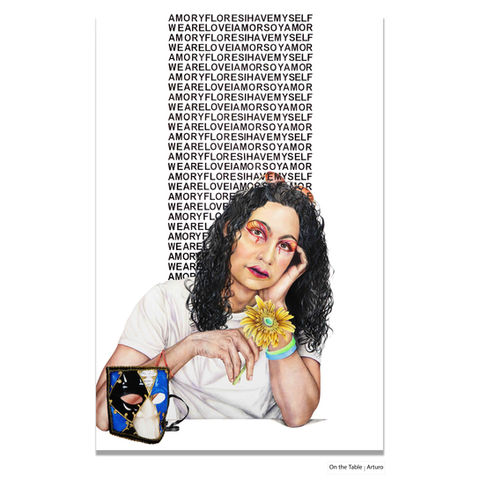
At The Table:The 2SLGBTQ+ Visibility Project
(formerly On the Table)
At the Table situates queer bodies within the language of Grand Manner portraiture—a tradition once designed to elevate monarchs and bureaucrats into symbols of authority. These portraits usurp that form, adopting its rigid poses, monumental scale, unsmiling gazes, and stripped-down white clothing to reveal both its absurdity and its exclusivity. When those once denied the frame claim it for themselves, the very premise of power begins to unravel.
Embedded within each work are bureaucratic fonts, the stark typefaces of laws, rulebooks, and state archives. In their original contexts they carried the quiet weight of authority, shaping lives while passing as neutral. In At the Table they are transformed. Bound to queer bodies rather than decrees, they shift from the language of exclusion to declarations of affirmation, carrying private words, resilience, and the insistence of presence.
The portraits mock and reclaim simultaneously. Hyperrealism renders each sitter undeniable, while a stuffed bear, a lemon, a dog, or a book on peace punctures the stiffness of the tradition, showing its pomp to be hollow. By overturning the visual grammar of authority, At the Table insists that no portrait tradition, no typeface, and no law holds the right to decide whose lives matter.
The Elements of the Series: Historical References & Other
1. The Seated Figure
Historic Codes of Power
-
In aristocratic and political portraiture, a seated pose often signaled authority, permanence, and status. The chair itself was a throne-like marker of rank.
-
Sitting wasn’t casual—it was a declaration: I belong here. I command this space.
-
Historically, who got “the seat” in art mirrored who had a seat in life.
-
The posture was part of a visual hierarchy—a system that told the viewer who mattered and who didn’t.
2. The Typography
Visual Language of Power
-
Bureaucratic fonts—rigid, uniform, utilitarian—signal control, compliance, and standardization. They appear in legal codes, forms, and institutional documents designed to enforce rules, strip individuality, and maintain hierarchies.
-
These were the kinds of typographic systems that carried policies regulating queer lives—laws that criminalized homosexuality, medical pathologization, government decrees. The fonts are not neutral; they are aesthetic evidence of systemic control.
3.The White
Absence & Stripping Away: Loss & Resistance
-
Historically, color in aristocratic portraiture signified wealth, status, and vitality (rich fabrics, deep tones, opulent textures). Removing that color creates a sense of emptiness or what has been taken away.
-
Mourning & Erasure: White often represents absence or erasure—a blank slate where identity has been stripped. For marginalized communities, it echoes the loss of visibility and cultural space.
-
Purity Turned Political: In queer and feminist movements, white has been reclaimed as a visual language of protest and neutrality that refuses ornamental codes of privilege.
-
Anti-Opulence: By dressing sitters in white, I reject the show of wealth and hierarchy embedded in historical portraiture. It becomes a radical simplification—saying: we do not play by your rules of power.
-
Queer Aesthetic of Refusal: It’s a deliberate denial of coded markers of “importance,” asserting value through presence rather than adornment.
4. The Objects
-
In classical and aristocratic portraiture, objects were coded symbols of wealth, education, power, and morality—books, instruments, fine fabrics, globes, religious items. They functioned as status signals.
-
These props weren’t neutral; they reinforced social hierarchies.
-
Each item in this series carries hidden narratives of pain, love, resistance, and joy. These aren’t decorative—they’re charged with meaning, like talismans or fragments of a life.
-
They allow for visual storytelling: a subtle, quiet language that operates alongside the sitter’s gaze and the embedded text.
-
By rejecting elitist symbols and replacing them with everyday things, you dismantle the historic idea that only certain lives are worth immortalizing.
-
You insist that ordinary people—those historically excluded from the frame—deserve the same monumental treatment as the powerful.
5. Hyper-realism
The Politics of Representation
-
Historically, power was immortalized through realism (royalty, clergy, state officials). By applying that same monumental precision to queer sitters, they claim the same cultural permanence historically reserved for elites.
-
It resists erasure—photographic realism says: this is real, this person exists, and you can’t ignore them.
-
Hyperrealism isn’t about showing off skill; it’s about forcing the world to look. These aren’t abstractions or softened depictions—they are recognizable, undeniable presences.
-
That recognition has stakes: being seen can mean being targeted. For some sitters, appearing in this work carries real danger.
-
Every portrait is built on intense trust. You’re asking your sitters to risk more than posing—they risk being “outed,” harassed, or even harmed because of how real these images are.
-
This heightens the ethical and emotional dimension of your work: it’s not just an image, it’s a collaboration steeped in courage.
-
In an era where anti-LGBTQ rhetoric is rising, hyperrealistic visibility is a radical refusal to disappear. It says: You want us erased? Here we are, bigger than life, looking you dead in the eye.







